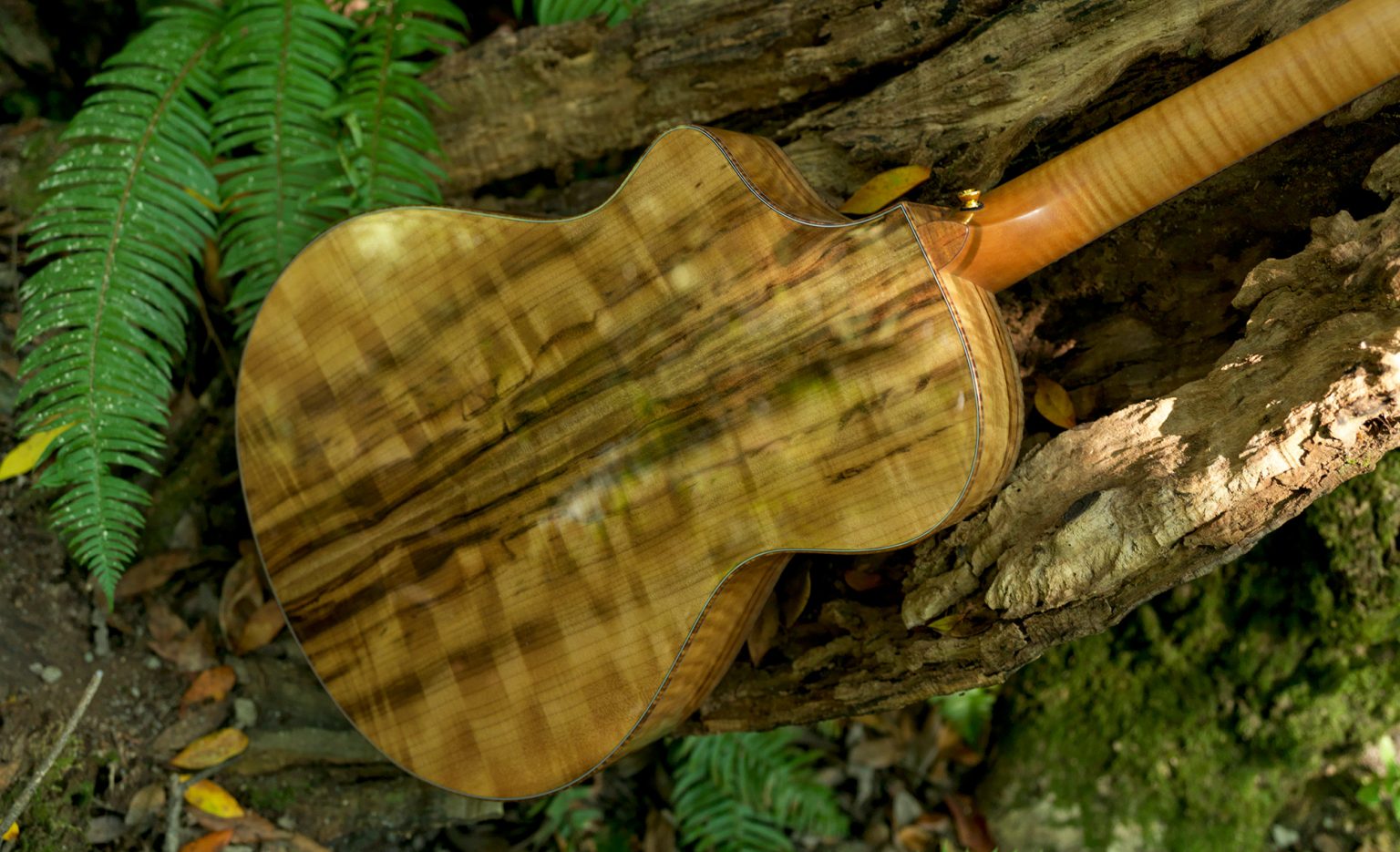
For everyone at Breedlove and most acoustic guitar players that we know, the art of tonewood selection isn’t only an aesthetic choice but a critical element in crafting an exceptional instrument. Myrtlewood, one of our favorites, presents some unique opportunities in this realm, and we want to explore them in this blog. We’ll delve into the considerations of tonewood pairing while focusing on the three Myrtlewood combinations we use most: Myrtlewood with Myrtlewood, Myrtlewood with Spruce, and Myrtlewood with Red Cedar.
The Significance of Tonewood Pairing
Tonewood pairing is the art of selecting and combining specific woods for the various parts of an acoustic guitar. It’s an obvious yet crucial element of guitar design for several reasons:
1. Tonal Balance and Character
Each tonewood possesses unique acoustic properties. Woods like rosewood can emphasize warmth, while others like maple emphasize attack and clarity. By pairing tonewoods strategically, we balance these properties to create an acoustic guitar with exactly the tone we want.
2. Responsiveness and Dynamic Range
The choice of tonewoods significantly influences a guitar’s responsiveness and dynamic range. Pairing woods with complementary characteristics can result in an instrument that responds quickly to your touch. It also determines the guitar’s voice when delicately picked and aggressively strummed.
3. Resonance and Sustain
A guitar’s resonance and sustain reflect the guitar’s construction, and the first step of that process is the materials. Each tonewood brings its natural resonance and sustain to the party. But when perfectly paired with others, they can enhance these characteristics, creating an instrument with a rich, beautiful sound.
4. Visual Appeal
Let’s not pretend looks don’t matter, and with acoustic guitars, tonewoods can be the most significant influence on its aesthetic appeal. Maybe you prefer the old-school contrast of a light top with the chocolatey browns on the sides and back. Or maybe Myrtlewood’s pale but golden hues catch your eye. Whatever you prefer, perfectly pairing tonewood can result in some visually stunning instruments. Here are some of our favorite Myrtlewood pairings.
Myrtlewood and Myrtlewood: All In on Oregon’s Native Tonewood
The pairing of Myrtlewood with more Myrtlewood may appear unorthodox. Not many acoustic guitars feature the same wood throughout. But it presents a fascinating tonal canvas. As we always say, Myrtlewood combines the tonal qualities of mahogany, rosewood, and maple. When used for the top, back, and side, it offers a full tonal character that’s warm, focused, and clear at the same time.
We love utilizing Myrtlewood for every component of our acoustic guitars, from the top to the back and sides. Our Made in Bend Oregon Series, as well as many of our Designed in Bend Pursuit Series, are perfect examples. If you’re looking for the Breedlove sound, they’re a great place to start.
Myrtlewood and Spruce: The Added Power of Spruce
The combination of Myrtlewood and Spruce is a textbook example of achieving versatile, responsive sound. Spruce, lauded for its structural strength, volume, and tonal clarity, blends seamlessly with the warmer side of Myrtlewood. Together, they are fantastic for a broad spectrum of playing styles.
The Myrtlewood and Spruce tonewood pairing is on full display throughout our Oregon Myrtlewood/Spruce and Organic Pro Artista Pro Series. From chord strumming to intricate fingerpicking, this tonewood combination ensures plenty of harmonic complexity with the added power of spruce.
Myrtlewood and Red Cedar: A Warmth-Driven Art
For players who appreciate the subtleties of fingerstyle and value warmth, the Myrtlewood and Red Cedar pairing is a revelation. Red Cedar is known for its warm, sweet tones and rapid responsiveness. It’s an almost ‘dry’ sound that helps every note ring out clearly and individually. Myrtlewood marries brilliantly with red cedar, adding weight and a roundness.
Because this duo is so perfect for intricate, expressive playing, it excels on classical and nylon string guitars like our Pursuit Exotic S Concert Nylon.
Tonewood Pairing is Critical, but it Isn’t Everything
While the pairing of tonewoods is essential to building any acoustic guitar, Breedlove takes things even further. Through our Sound Optimization process and Cascade Bracing, we further tune these tonewoods to ensure each one sounds and performs flawlessly. In fact, every Made in Bend Breedlove acoustic guitar is hand-tuned multiple times through the build process to make sure of it. So, yes, it’s vital to pair tonewoods perfectly. We just make them more perfect after that.
Myrtlewood, Cedar, Spruce, and Beyond
The technical exploration of tonewood pairings is a beautiful journey that can take a lifetime. That’s why we’ve chosen to only focus on Myrtlewood pairings here. Whether you opt for the all-Myrtlewood route, the punchier Myrtlewood and spruce pairing, or an articulate and detailed Myrtlewood and red cedar classical, Breedlove has the ideal acoustic guitar for you.
